Kayak anglers call fishing nets a necessary evil. Necessary because a fishing net is the best way to move a fish from the water to the kayak. Evil because a fishing net gets in the way, snags hooks and tangles on rod holders, fishing rods, reel handles and everything else in the kayak. To get the best advantages with the least evil, look for a net that will scoop up the biggest fish and take up the least space. To find the best fishing net, consider the size of the fish you target and how you will store the net in the kayak. Within these guidelines, there are a lot of great choices for fishing nets.
Top Picks: Best Fishing Nets
The following fishing nets have received the highest star ratings from reviewers in our Kayak Angler Buyer’s Guide. See and review all fishing nets here.
Best Fishing Nets
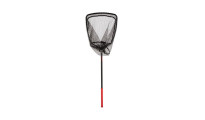
Carbon Fiber Fishing Net, Small
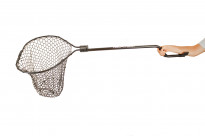
Leverage Landing Net®, 20'' x 21'' Hoop with XL Handle

Nomad Mid-Length Net
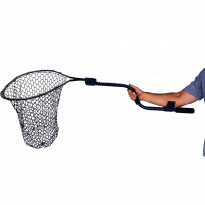
Leverage Landing Net®, 20'' x 21'' Hoop with Foam Extension
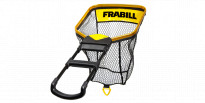
Bearclaw Net
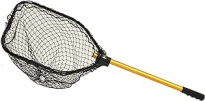
Power Stow Poly Net
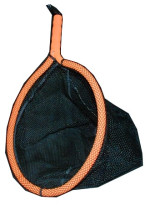
G2 Pro Net
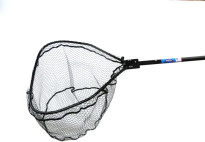
Tournament Series Landing Net

Carbon Fiber Fishing Net, Medium
Shop for Fishing Nets
The best way to shop for a fishing net is by comparing features and dimensions. If you can’t get to the tackle shop to compare fishing nets, the next best option is shopping the extensive selection of fishing nets at online retailers. This section will take you to our Kayak Angler Buyer’s Guide where you can find every fishing net on the market, including specs, prices, reviews and where to buy.
Shop by brand
Fishing Net Buying Guide
You’ve been fishing all day without a bite. Finally, a fish crashes your lure and takes off for the horizon. You fight the fish out of the weeds, through the branches of a downed tree, under the kayak and around the bow. Suddenly, the trophy is boatside. Whatever you do, don’t screw it up.
Now, aren’t you glad you brought your fishing net?
A fishing net can improve a kayak angler’s chances of landing a fish. That said, choosing to use a net is a matter of personal preference and isn’t strictly necessary. I have fished out of a kayak for over 20 years and don’t carry a fishing net. Since I fish out of a low-profile paddle kayak, I use my leg to help slide large fish into the cockpit. But I admit, I’ve lost fish I would have landed with a net.
Other anglers swear by their nets. Anglers sitting high off the water in an elevated frame seat especially need a landing net to lift the fish into the kayak. If you are a tournament angler and a fish is on the line, you’ll want a landing net to increase your odds of scoring the winner and cashing a check.
The good news is no matter your target species, there is a fishing net to help scoop up your catch. To choose the best fishing net, a kayak angler needs to consider the size, shape, durability and convenience of the tool. A fishing net should complement your fishing instead of being an impediment. Here are the five most important considerations when choosing a net:
1 Size
The hoop shape, size and net depth should match the size of your primary target species. A bigger fish needs a bigger net, of course. Larger, deeper nets are suited to bigger and more powerful species like salmon, striped bass and pike, while smaller, shallower nets are ideal for species like trout and crappie. The net’s handle must be long enough to comfortably reach the water from your kayak seat. If fishing from an elevated frame seat, an angler will want a net with a handle at least 36 inches long. Anglers in sit-inside kayaks might be able to use nets with handles as short as 11 inches.
2 Construction
The materials a net is constructed with affect its weight, performance and lifespan. Handles are typically manufactured with aluminum, fiberglass or wood. Aluminum is light and long-lasting with a corrosion-resistant finish, though it may bend under extreme pressure. Fiberglass offers a good balance between weight and strength. And while wood handles are heavier, they have a classic look many anglers appreciate. Wood handles are less practical in saltwater environments and, even with regular maintenance, are prone to rot. Whichever you choose, opt for a net with corrosion-resistant components and fade-resistant webbing. Spending a little extra money on a net with high-quality materials will pay off with years of reliable service.
3 Fish Health
A net can help land a fish and minimize handling time, hopefully causing less stress and injury. This is important for catch-and-release fishing. While net mesh is commonly made with nylon webbing, conservation-minded anglers prefer rubber-coated webbing to protect fragile fish. The rubberized webbing reduces injury to the fish by protecting its slime coat. For the fisherman, rubber webbing makes removing a hook snagged in the mesh easier. This feature costs more, but it saves time and helps the fish.
4 Storage
Space is at a premium on a fishing kayak, so determine where you will store the net before you buy and choose a net that fits the available space. Popular storage spots with varying degrees of accessibility include the tankwell, inside a hatch, in a rod holder or on the bow. Be warned that a poorly stored net will get hung up on hooks and cause a headache. One way to save space is opting for net with a folding hoop and collapsible handle. But while this style of net makes storage easier, it adds an extra step to deployment in the heat of the moment.
5 Buoyancy
Most importantly, don’t forget that the best kayak fishing net floats.

Best Fishing Nets for Target Species
Trout Fishing Nets
A trout landing net allows a wade angler to control a trout without taking the fish out of the water. Traditional trout landing nets have a short handle and a small hoop to fit in a fly fishing vest or sling over the angler’s back. Many anglers prefer rubber-coated webbing to protect the trout’s slimecoat. To reach the water from a kayak or river bank, look for a trout net with a longer handle.
Bass Fishing Nets
When a lunker is on the line, the best bass landing net is quick and easy to deploy. A battle with a big bass may only last a few seconds, so an angler must be quick to scoop up the fish. The best bass landing net has a reliable fixed handle always ready to land a trophy bass. However, kayak anglers don’t have space for a fixed-handle net, so a net with a collapsing or folding handle is the best. A collapsing handle is great for transporting the net. While you’re fishing, extend the handle and store the net on the bow. Anglers with limited space appreciate a folding handle. While you’re fishing you can store the net with the handle folded. When the fish is on the hook, grab the handle and flip open the net. Kayak anglers like a net with a forearm grip to fight the fish with one hand and operate the net with the other. And a shallow net won’t interfere with landing the fish. Bass anglers also like a net with rubber webbing. Not only is it better for the fish, but the rubberized net doesn’t snag hooks like string webbing.
Salmon Fishing Nets
Salmon grow large, so a salmon landing net needs a big, deep hoop. Anglers trolling for salmon prefer a long handle to reach out and scoop up a big fish. Kayak anglers don’t have space for a large net. The best bet is to land the salmon without a net or use a fishing net with a large hoop and a short handle. To release salmon in the best possible condition, salmon anglers use a net with rubberized webbing.
Fly Fishing Nets
Wade anglers look for a fly fishing net they can store in their fishing vest or on a lanyard. For boat, kayak and bank fishing, use a net with a handle long enough to reach the water. Fly anglers often use light leader and small hooks, so a fly fishing net should be quick to deploy and easy to swing and scoop into the water. A lightweight net with a small hoop and shallow net easily moves through the water.
Saltwater Fishing Nets
To survive the marine environment, a saltwater saltwater landing net needs to be tough. Corrosion-resistant materials and components, sturdy construction and fade and rot-resistant webbing are the best defence against salt, sun and sand. Large saltwater fish require a large hoop and deep net. One way to save space is with a net that has a folding hoop and a collapsing handle.
Fishing Net FAQ
We gathered the most commonly asked questions about fishing nets for kayak anglers. Here’s what you need to know.
-
How does a fish landing net work?
After losing several fish due to landing net mishaps, you might ask how a landing net works. The secret to properly netting a fish is holding the net still and using the fishing rod to bring the fish to the net. Chasing the fish with the net often results in knocking the fish off the hook. Wait until the fish is tired and swimming slowly before dropping the net in the water. Be careful not to snag the net webbing with the hook or tangle the line as you guide the fish into the hoop. When the fish is over the hoop, lift the net to scoop the fish out of the water. Once the fish is on deck, use the net to keep it from injuring itself or damaging gear. Leave the fish in the net while removing the hook. If you are releasing the fish, use the net to lower the fish into the water and revive it.
-
Do kayak anglers need a fishing net?
Do kayak anglers need a fishing net? The answer depends on who you ask. I have fished out of a kayak for over 20 years and I’ve never carried a fishing net. My primary targets are redfish, speckled trout and striped bass, and they don’t require a net to land. And, since I fish out of a low-profile paddle kayak, so I can use my leg to help slide the fish into the cockpit. Of course, I’ve lost fish I might have landed with a net. To me, the hassle of dealing with a net in a kayak isn’t worth a couple of lost fish.
Other anglers disagree. Sitting high off the water in a pedal kayak with an elevated frame seat often requires a landing net to lift the fish into the boat. If you are a tournament angler and the big-money fish is on the line, you’ll want a landing net to increase your odds of scoring the fish and cashing a check.
Fly anglers using small hooks and light leaders need a landing net to avoid breaking the line or pulling the hook. Delicate fish like freshwater trout are best handled with a fishing net. The net supports the fish’s weight when you lift it out of the water. To further reduce injury, you can unhook and release the fish without touching it with your hands.
The only time I carry a landing net is when I’m targeting snakehead. These powerful fish are famous for opening a can of whoop ass when they hit the deck. The fishing net prevents the powerful snakehead from thrashing around and swinging sharp hooks. When you’re dealing with violent fish and sharp hooks, a fishing net becomes a safety feature.

-
Where to buy a fishing net?
Fishing nets are available everywhere from local tackle shops to big box stores and online retailers. For the best selection of the most popular nets, shop at a tackle store or outfitter where you can test the features and ask the shop staff for advice. At a large outdoors retailer, you’ll find a wide variety of nets, but the selection may not be specific to the local fishing. You can buy a fishing net at Walmart and other big box stores. Of course, you can find every fishing net available at online retailers. You can’t test a net before you buy online, but you can read reviews and compare prices to find the best fishing net at the Kayak Angler Buyer’s Guide.
Fishing Net Reviews
Coming soon
Securing your catch of the day. | Feature photo: Robert Faubert


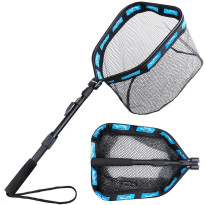
 This article was first published in the Spring 2024 issue of Paddling Magazine.
This article was first published in the Spring 2024 issue of Paddling Magazine. 